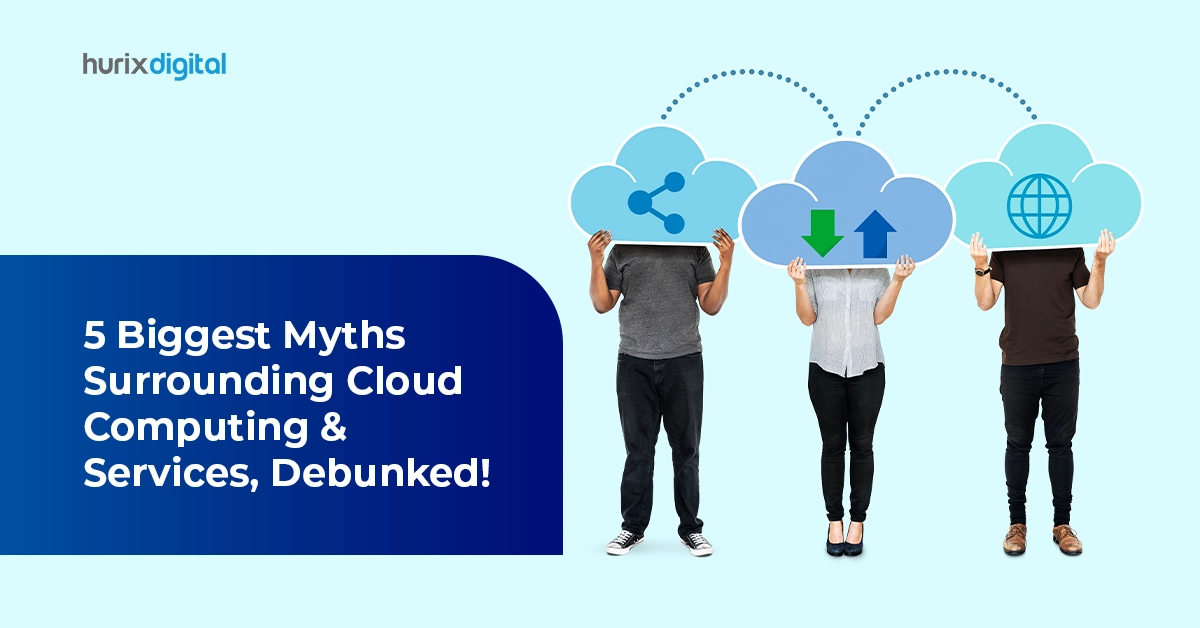5 Biggest Myths Surrounding Cloud Computing & Services, Debunked!
Cloud Services have been in existence past few decades and in the past decade, their adoption level has been growing remarkably. In the last decade, cloud computing has been a buzz word and cloud adoption has been one of the top agendas of most of the CIOs or head of IT.
Businesses are aspiring to take their IT infrastructure and services to the cloud to make them highly available, scalable, resilient, high-performing, cost-effective, and secure. But still, 5 myths around cloud services must be demystified so that businesses can make the right decision while adopting cloud services so that they can adopt the cloud with full confidence and cannot be disappointed once on the cloud.
Here are the top 5 Cloud Technology myths, debunked!
Table of Contents:
Myth #1: Once your IT infrastructure and services are on the cloud, they will be highly available.
This is a very common perception that just being on the cloud ensures high availability by default. That is not correct because the cloud guarantees high availability only if your infrastructure and services are designed, architected, and configured as per the cloud services provider recommendations; not by default.
Cloud services providers host their services in data centers and all data centers are grouped based on their geographical presence. These groups of data centers are specific to a geographical area called a zone or a region. Once you launch a cloud service on the cloud, by default your service is hosted on any of the data centers of your chosen zone or region.
Though cloud services providers build local redundancy, high availability, and disaster recovery mechanisms of one regional data center to another in the same region but what if the entire region (the specific geographical area) is affected by a natural disaster or any other massive issue cripples the entire region then all data centers of that region will be affected and so does your cloud services. That’s why cloud services providers recommend all mission-critical IT services to be hosted in more than one cloud region and high availability & disaster recovery mechanisms to be configured using globally redundant network and data services.
All cloud service providers offer services to be hosted with local redundancy or global redundancy. They recommend all business-as-usual IT services to be hosted on cloud services that have local redundancy and all the mission-critical ones to be hosted on globally redundant cloud services so that irrespective of any disaster in one region, the mission-critical services can run uninterrupted from another cloud region that is not impacted by the regional disaster.
So the bottom line is the fact that the cloud is highly available but not by default, you will have to design, architect, and configure it as per the recommended redundancy level to enjoy the high availability.
Also Read: The Impact of TaaS in Cloud Computing on Rapid Business Operations
Myth #2: Once your IT infrastructure and services are on the cloud, they will be highly secure.
This is another myth occupying most of the cloud-adoption aspiring businesses. They think that their IT infrastructure and services will be highly secure, providing maximum data security, just by moving them from their on-premise data centers. This, in principle, is true, but not by default.
Cloud services providers give specific cloud platform access to their customers to launch specific cloud services so that those customers can launch cloud services and host their IT infrastructure and services on them. Protecting the cloud platforms from any kind of data security threats is the responsibility of the cloud services provider and they do it very well. But, protecting the customer-launched services from security threats comes under the responsibility of the cloud customer.
It does not mean that the cloud services providers do not do anything to protect the customer-launched cloud services, they do by providing many security services available on the cloud to protect customer-launched cloud services. They also recommend many best practices to make customer-launched services accessible over the internet and also internally within the cloud virtual network. So all businesses must make the best use of the available data security services and also the recommended security configuration best practices to make their IT infrastructure and services highly secure.
So, IT infrastructure and services will be highly secure once hosted on the cloud, but not by default. Instead, they will be so by use of recommended security services and configuration.
Myth #3: Hosting IT infrastructure and services on the cloud is cost-effective compared to hosting the same on-premises.
Cost-effectiveness is one of the most desired motivations behind cloud adoption. Most businesses desire to go to the cloud just to make their IT infrastructure and services cost-effective.
Cloud services providers offer many ways to make IT infrastructure and services hosted on the cloud cost-effective so businesses moving their IT infrastructure and services to the cloud can make the best use of the same to fulfill their desire to have a cost-effective IT technology stack on the cloud. However, they need to be clear that their IT technology stack is not going to be cost-effective on the cloud by default. They will have to use the cloud service provider’s recommended methods to enjoy cost-effective IT services on the cloud.
Some of the well-known cost control methods are up-front payment for cloud services for an entire year or few years, use of auto-scaling to upscale and downscale services capacity as per the load on the services, auto shut down and auto restart of services during usage or no usage hours, etc. So cloud-adopting businesses need to make the best use of such cost-effective methods to make their IT services cost-effective on the cloud because they are not going to be cost-effective by default.
Myth #4: Hosting IT infrastructure and services on the cloud will make them confined to a cloud provider and rolling back to on-premises or another cloud provider will be very difficult.
Many businesses desire to take their IT infrastructure and services to the cloud but they fear getting locked with one cloud provider and find getting back to the previous mode of IT infrastructure and services hosting kind of impossible. They also find switching over to another cloud provider very challenging. Nowadays, every cloud provider offers very user-friendly and easy-to-use tools to migrate customers from on-premise to the cloud and vice versa.
The cloud strategy provider also offer tools to migrate customers from other cloud providers. So any cloud adoption aspiring business does not need to have any fear of confinement with one cloud provider and lack of easy ways to get back to the previous mode of IT services hosting or switching over to another cloud services provider in case of any service issue with the existing one.
Myth #5: Hosting IT infrastructure and services on the cloud will make them non-compliant with local country-specific or business domain-specific data protection laws.
Nowadays, cloud providers have a very clear understanding of local, country-specific, or business domain-specific data protection laws and they have cloud services offerings that empower businesses to host their IT infrastructure and services in some specialized data centers that are built keeping these compliance requirements in mind.
In such data centers, businesses can have compliance expected level of control on their data sets and they will also be getting all the required artifacts to justify their compliance requirements. So rather than worrying about this myth, businesses need to plan their cloud adoption journey but only after clearly articulating their compliance needs to their prospective cloud services providers so that they can be suggested the right type of cloud services to meet their compliance requirements.
Also Read: The Revolution of AI in Cloud Computing: Transforming Education and Work
Conclusion
Cloud adoption is happening on the rise, and is now considered to be the standard in digital transformation journey. Choosing the right cloud computing provider will help your business grow leaps and bounds.
One such cloud service provider is Hurix Digital. With a team of experts that specializes in knowing your requirements, and delivering the best for your business, you are sure to see immense growth.
Get in touch with Hurix Digital to know more about the world of cloud computing and data security.

Vice President & Business Unit Head – Cloud Services
A top technology management voice on LinkedIn with 20 Years of experience in Information Technology, Cloud Services, Digital Transformation, Application Modernisation, Managed Services, IT Security Engineering and Operations Management. An avid technology Leader, Leadership Speaker, Author & Coach.









